Ketosis: What It Is and How to Achieve It
Introduction
As we constantly strive to unlock the secrets of optimal health and well-being, one concept that has been gaining significant traction is ketosis. It’s a term that has resonated within the health community, often associated with a low-carb diet and credited with a host of potential benefits, from weight loss to improved mental clarity. But what exactly is ketosis, and how can one achieve it? In this article, we’ll delve into the fascinating world of ketosis, demystifying its complexities and detailing a roadmap for those aiming to embark on this journey.
Understanding Ketosis
In simple terms, ketosis is a metabolic state where your body, in the absence of enough glucose (sugar) for energy, burns stored fat. This process results in the production of molecules called ketones, which are then used as a primary source of energy.
Typically, our bodies run on glucose, obtained from carbohydrates found in foods like fruits, vegetables, and grains. However, when we drastically reduce our carb intake, our bodies have to look elsewhere for energy. That’s where stored fat steps in, and ketosis begins.
The Benefits of Ketosis
Numerous studies have highlighted the potential benefits of being in a state of ketosis. Some of these include:
- Weight loss: The body turns to its fat reserves for energy, leading to weight loss. This aspect makes ketosis a popular strategy for those aiming to lose weight.
- Reduced hunger: Ketosis often leads to a decrease in hunger and a reduction in the desire to eat, making it easier to stick to a diet.
- Improved mental clarity: Some individuals report better concentration and focus when in ketosis, although this can vary from person to person.
How to Achieve Ketosis
Achieving ketosis involves a significant shift in dietary habits. Here are some steps to help you get there:
- Limit your carb intake: This is the most critical aspect. The standard ketogenic diet recommends consuming no more than 20-50 grams of carbs per day.
- Increase healthy fat intake: Since your body will be using fat for fuel, it’s important to include healthy fats in your diet. Avocados, olive oil, and fatty fish are good examples.
- Include moderate protein: While it’s essential to limit carbs and increase fats, a moderate intake of protein should be maintained. Too much protein can interfere with ketosis.
- Stay active: Regular physical activity can help your body enter ketosis faster.
Remember, it’s always crucial to consult with a healthcare professional before making significant changes to your diet or lifestyle. They can provide personalized advice and ensure you’re approaching ketosis safely.
Conclusion
Ketosis is a fascinating metabolic state that can offer a range of potential benefits. However, it requires a significant commitment to dietary changes. As with all matters of health and well-being, it’s not a one-size-fits-all solution, and individual experiences can vary. But with the right guidance and a sound understanding of what to expect, achieving ketosis can be a transformative journey towards better health.



